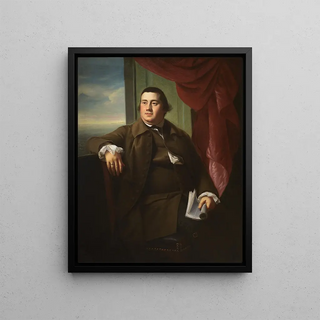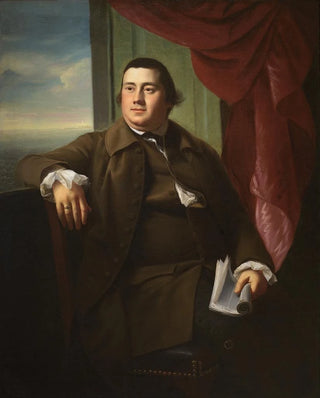Art print | Robert Hooper - John Singleton Copley


View from behind

Frame (optional)
In the fascinating world of 18th-century painting, the "Robert Hooper" art print by John Singleton Copley stands out for its ability to capture the very essence of its subjects. This depiction of a man in a suit, imbued with dignity and gravity, transports us to a time when the portrait was much more than a simple image. Copley, a master of the portrait, manages to establish a dialogue between the viewer and the model, revealing not only external appearance but also a psychological depth that invites contemplation. The art print of Robert Hooper - John Singleton Copley thus allows us to rediscover this masterpiece from a new perspective, while preserving the integrity of the original work.
Style and uniqueness of the work
Copley is recognized for his realistic approach and meticulous attention to detail. In "Robert Hooper," every element, from the draping of the clothing to facial expressions, is carefully crafted to reflect the personality of the subject. The lighting, skillfully orchestrated, plays a crucial role in highlighting Hooper's features, emphasizing both his stature and character. The color palette, subtly chosen, evokes an atmosphere that is both warm and solemn, enhancing the emotional impact of the work. This portrait does not merely freeze a moment; it tells a story, that of a man rooted in his time, while hinting at the aspirations and challenges of his era. Copley's technical mastery, combined with his artistic sensitivity, gives this piece a singularity that continues to fascinate art lovers across the centuries.
The artist and his influence
John Singleton Copley, born in Boston in 1738, is often regarded as one of the greatest portraitists of his time. His ability to blend realism and psychology in his works not only marked his era but also influenced many artists who followed him. Copley captured the spirit of colonial America, while drawing inspiration from European masters, notably the Flemish school and the British tradition. His unique style paved the way for a new understanding of the portrait, where the individual is perceived in its entirety.

Matte finish

View from behind

Frame (optional)
In the fascinating world of 18th-century painting, the "Robert Hooper" art print by John Singleton Copley stands out for its ability to capture the very essence of its subjects. This depiction of a man in a suit, imbued with dignity and gravity, transports us to a time when the portrait was much more than a simple image. Copley, a master of the portrait, manages to establish a dialogue between the viewer and the model, revealing not only external appearance but also a psychological depth that invites contemplation. The art print of Robert Hooper - John Singleton Copley thus allows us to rediscover this masterpiece from a new perspective, while preserving the integrity of the original work.
Style and uniqueness of the work
Copley is recognized for his realistic approach and meticulous attention to detail. In "Robert Hooper," every element, from the draping of the clothing to facial expressions, is carefully crafted to reflect the personality of the subject. The lighting, skillfully orchestrated, plays a crucial role in highlighting Hooper's features, emphasizing both his stature and character. The color palette, subtly chosen, evokes an atmosphere that is both warm and solemn, enhancing the emotional impact of the work. This portrait does not merely freeze a moment; it tells a story, that of a man rooted in his time, while hinting at the aspirations and challenges of his era. Copley's technical mastery, combined with his artistic sensitivity, gives this piece a singularity that continues to fascinate art lovers across the centuries.
The artist and his influence
John Singleton Copley, born in Boston in 1738, is often regarded as one of the greatest portraitists of his time. His ability to blend realism and psychology in his works not only marked his era but also influenced many artists who followed him. Copley captured the spirit of colonial America, while drawing inspiration from European masters, notably the Flemish school and the British tradition. His unique style paved the way for a new understanding of the portrait, where the individual is perceived in its entirety.






